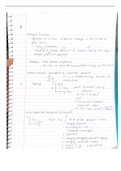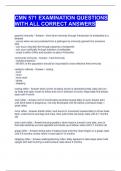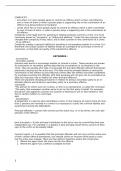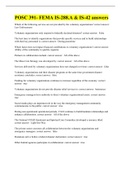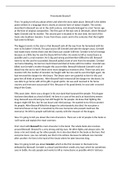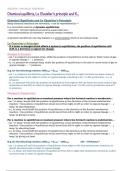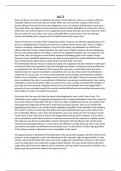ProRes. Org. 3
Lecture one: Chapter 1 & Article van de Ven
Changes in strategy
- Strategic/transformational change: organizational shift in the context of environmental
developments
- Involves a redefinition of mission and purpose and a shift in goals, to reflect a
new direction in response to environmental threats
- Hard: involves changes in patterns of resource allocation, organization structure and
processes
- Soft: involves changes in central beliefs that members of an organization hold about
the organization, nature of its environment, competition and how it competes
The schools of thought on how change occurs in organizations
1. Punctuated equilibrium model of change: organizations evolve through relatively long periods
of stability, which are then interspersed by shorter periods of more fundamental change
- Convergent change: adaptation within the way of doing, leads to extension and
continuity of the past
- More likely to apply to industries where changes to the competitive conditions occur less
frequently and in which it is possible to remain competitive without making changes
- Leads to increasing independence between organizational domains of activity
- Revolutionary change: transformational change achieved through a simultaneous change
in strategy, structure etc… leading to a radically different way of operating
2. Continuous model of change: possible to transform an organization incrementally through
time, leading to the same outcome as revolutionary change, however in less dramatic fashion
- Emergent change: more suited to a more operational level and less likely to deliver a
transformational shift
Organizations and strategic change
- Strategic drift: gap between what the organization is doing and what it needs to be doing to
be competitive in its marketplace
- As this gap widens, performance will start to decrease (thus less profitable)
- Changes are not adequate enough for the organization to keep up with changes in the
competitive environment
Context-specific change
1. Change content: the way and what of change; an outline of the required future state of the
organization and its relationship to the current state (related to goals, resource or identity)
2. Change process (transition): internal and external context should be seen as a starting point
to determine the appropriate change process, about transition and how change is implemented
3. Outer context: external (competitive) environment
4. Inner context: internal organizational context (e.g., control systems, power and politics of the
organization)
,Context specific change: managerial capabilities for change agents (change process/ transition) - AJTI
1. Analytical skills: to create a holistic picture of the organization (inner context)
- Without these, it is easy to draw upon ready-made change recipes
2. Judgmental skills: to recognize what is critical in a particular change context and design a
change process that addresses it
- Without these, change agents can miss the most critical aspect of the change context
3. Translation skills: moving between vocabularies associated with the formulation of strategy
and vocabularies of change implementation
- Without these, good ideas may never be converted into meaningful activities
4. Implementation skills: to take action and decide on which intervention to make and in what
order to apply them
- Without these, the process can remain a planning exercise which never tackles the
reality of change within the organization
The transition state: designing context-sensitive approaches to change (analytical/judgemental skills)
- The transition state: the process of changing the organization from what it is now to the
desired future organization (the process of making desired changes happen)
- Can only be designed once the current organizational state is understood and the
desired future organizational state has been specified
- Internal and external context is analyzed in order to gain an understanding of why change is
necessary and the current state
- Context-specific change approach: requires a change agent to draw on their analytical and
judgemental skills
- After this an analysis of the change context is held, this finds features relevant to change
- With this analysis the agent judges which the most critical features of the change situation
are
- Finally, the agent considers the appropriate design choices
The change kaleidoscope: consists of 3 rings (organizational strategic context, change contextual
features and design choices)
1. Organizational strategic context: the broader strategic analysis conducted to determine why
the organization should change and what should be changed
2. Change contextual features: aspects to do with culture, competencies and current situation,
which change agents should consider before selecting the change approach
3. Design choices: the range of options a change agent needs to choose from when selecting an
appropriate change approach
The transition state: design and management (translation/implementation skills)
- Through the use of levers and mechanisms, a change agent can achieve the wanted
behavioural change
Change processes: a broader picture (van de Ven & Poole)
Terminology:
- Change process: a progression of change events that unfold during an entity’s existence
- Process theory: explanation of how and why an organizational entity changes and develops
1
,The life cycle theory:
- Event progression: linear and irreversible/sequence of prescribed stages, from 1 to 2…
- Generating force: prefigured program, a rule regulated by nature, logic or institutions
- Examples: FDA approval process, human life, stage-gate product development
The teleological theory:
- Event progression: goal setting, implementation, evaluation and modification of goals based
on learnings (doing a project with a student team), less regulated than the life cycle theory
- Generating force: goal enactment, consensus on means and cooperation
- Examples: strategy formulation/implementation and purposeful learning
The dialectical theory:
- Event progression: sequence of confrontation, conflict and synthesis between contradictory
values/events
- Generating force: conflict and confrontation, make us move stages because of the creation of
perspectives
- Example: developments based on conflicts in the organization
The evolutionary theory:
- Event progression: recurrent sequences of variation, selection and retention (survival of the
fittest)
- Generating force: scarcity, competition
- Example: the development of a dominant design; development of the Coronavirus
2
, Lecture two: Chapter 2 & 3
Chapter two:
Design choices and its six categories
- Design choices: plan on the transition process. Has to be assessed in relationship to the inner
context of the organization
Six categories:
1. Change path: change undertaken in terms of nature of change and the desired result
- In some circumstances it is necessary to undertake an enabling phase of change before
it is possible to undertake the actual changes required (first/most important choice)
2. Change start-point: where change is started, initiated and developed (top-down or bottom-up)
3. Change style: management style of implementation, highly collaborative or more directive
4. Change target: the target of change interventions, in terms of people’s attitudes and values,
behaviours and patterns
5. Change levers: the range of levers and interventions to be deployed across four subsystems;
technical, interpersonal, political and cultural
6. Change roles: who is to take responsibility for leading and implementing the changes
The different types of change and its dimensions(change path)
- Change path: focusses on choices in terms of these types of changes, as well as how these
different types can be combined to deliver a more phased approach to change
Types of change:
1. Adaptation: less fundamental change
implemented slowly through staged initiatives
2. Reconstruction: change undertaken to realign the
way the organization operates (forced/reactive)
3. Evolution: transformational change implemented
gradually through different stages and interrelated
initiatives
4. Revolution: transformational change occurring
via initiatives on many fronts, often in a relatively
short space of time (forced/reactive)
Often observed change path: reconstruction followed by
evolution organizational change follows economic change)
The dimensions: provide explanation for types of change
1. End result of change: the extend of change desired (more complicated to assess)
2. Nature of change (timing): the way change is implemented, all at one, big-bang fashion
(period of about 18 months) or a more incremental fashion
Change in core of organization:
about mission, assumptions + believes
(=paradigm) values or identity
3
Lecture one: Chapter 1 & Article van de Ven
Changes in strategy
- Strategic/transformational change: organizational shift in the context of environmental
developments
- Involves a redefinition of mission and purpose and a shift in goals, to reflect a
new direction in response to environmental threats
- Hard: involves changes in patterns of resource allocation, organization structure and
processes
- Soft: involves changes in central beliefs that members of an organization hold about
the organization, nature of its environment, competition and how it competes
The schools of thought on how change occurs in organizations
1. Punctuated equilibrium model of change: organizations evolve through relatively long periods
of stability, which are then interspersed by shorter periods of more fundamental change
- Convergent change: adaptation within the way of doing, leads to extension and
continuity of the past
- More likely to apply to industries where changes to the competitive conditions occur less
frequently and in which it is possible to remain competitive without making changes
- Leads to increasing independence between organizational domains of activity
- Revolutionary change: transformational change achieved through a simultaneous change
in strategy, structure etc… leading to a radically different way of operating
2. Continuous model of change: possible to transform an organization incrementally through
time, leading to the same outcome as revolutionary change, however in less dramatic fashion
- Emergent change: more suited to a more operational level and less likely to deliver a
transformational shift
Organizations and strategic change
- Strategic drift: gap between what the organization is doing and what it needs to be doing to
be competitive in its marketplace
- As this gap widens, performance will start to decrease (thus less profitable)
- Changes are not adequate enough for the organization to keep up with changes in the
competitive environment
Context-specific change
1. Change content: the way and what of change; an outline of the required future state of the
organization and its relationship to the current state (related to goals, resource or identity)
2. Change process (transition): internal and external context should be seen as a starting point
to determine the appropriate change process, about transition and how change is implemented
3. Outer context: external (competitive) environment
4. Inner context: internal organizational context (e.g., control systems, power and politics of the
organization)
,Context specific change: managerial capabilities for change agents (change process/ transition) - AJTI
1. Analytical skills: to create a holistic picture of the organization (inner context)
- Without these, it is easy to draw upon ready-made change recipes
2. Judgmental skills: to recognize what is critical in a particular change context and design a
change process that addresses it
- Without these, change agents can miss the most critical aspect of the change context
3. Translation skills: moving between vocabularies associated with the formulation of strategy
and vocabularies of change implementation
- Without these, good ideas may never be converted into meaningful activities
4. Implementation skills: to take action and decide on which intervention to make and in what
order to apply them
- Without these, the process can remain a planning exercise which never tackles the
reality of change within the organization
The transition state: designing context-sensitive approaches to change (analytical/judgemental skills)
- The transition state: the process of changing the organization from what it is now to the
desired future organization (the process of making desired changes happen)
- Can only be designed once the current organizational state is understood and the
desired future organizational state has been specified
- Internal and external context is analyzed in order to gain an understanding of why change is
necessary and the current state
- Context-specific change approach: requires a change agent to draw on their analytical and
judgemental skills
- After this an analysis of the change context is held, this finds features relevant to change
- With this analysis the agent judges which the most critical features of the change situation
are
- Finally, the agent considers the appropriate design choices
The change kaleidoscope: consists of 3 rings (organizational strategic context, change contextual
features and design choices)
1. Organizational strategic context: the broader strategic analysis conducted to determine why
the organization should change and what should be changed
2. Change contextual features: aspects to do with culture, competencies and current situation,
which change agents should consider before selecting the change approach
3. Design choices: the range of options a change agent needs to choose from when selecting an
appropriate change approach
The transition state: design and management (translation/implementation skills)
- Through the use of levers and mechanisms, a change agent can achieve the wanted
behavioural change
Change processes: a broader picture (van de Ven & Poole)
Terminology:
- Change process: a progression of change events that unfold during an entity’s existence
- Process theory: explanation of how and why an organizational entity changes and develops
1
,The life cycle theory:
- Event progression: linear and irreversible/sequence of prescribed stages, from 1 to 2…
- Generating force: prefigured program, a rule regulated by nature, logic or institutions
- Examples: FDA approval process, human life, stage-gate product development
The teleological theory:
- Event progression: goal setting, implementation, evaluation and modification of goals based
on learnings (doing a project with a student team), less regulated than the life cycle theory
- Generating force: goal enactment, consensus on means and cooperation
- Examples: strategy formulation/implementation and purposeful learning
The dialectical theory:
- Event progression: sequence of confrontation, conflict and synthesis between contradictory
values/events
- Generating force: conflict and confrontation, make us move stages because of the creation of
perspectives
- Example: developments based on conflicts in the organization
The evolutionary theory:
- Event progression: recurrent sequences of variation, selection and retention (survival of the
fittest)
- Generating force: scarcity, competition
- Example: the development of a dominant design; development of the Coronavirus
2
, Lecture two: Chapter 2 & 3
Chapter two:
Design choices and its six categories
- Design choices: plan on the transition process. Has to be assessed in relationship to the inner
context of the organization
Six categories:
1. Change path: change undertaken in terms of nature of change and the desired result
- In some circumstances it is necessary to undertake an enabling phase of change before
it is possible to undertake the actual changes required (first/most important choice)
2. Change start-point: where change is started, initiated and developed (top-down or bottom-up)
3. Change style: management style of implementation, highly collaborative or more directive
4. Change target: the target of change interventions, in terms of people’s attitudes and values,
behaviours and patterns
5. Change levers: the range of levers and interventions to be deployed across four subsystems;
technical, interpersonal, political and cultural
6. Change roles: who is to take responsibility for leading and implementing the changes
The different types of change and its dimensions(change path)
- Change path: focusses on choices in terms of these types of changes, as well as how these
different types can be combined to deliver a more phased approach to change
Types of change:
1. Adaptation: less fundamental change
implemented slowly through staged initiatives
2. Reconstruction: change undertaken to realign the
way the organization operates (forced/reactive)
3. Evolution: transformational change implemented
gradually through different stages and interrelated
initiatives
4. Revolution: transformational change occurring
via initiatives on many fronts, often in a relatively
short space of time (forced/reactive)
Often observed change path: reconstruction followed by
evolution organizational change follows economic change)
The dimensions: provide explanation for types of change
1. End result of change: the extend of change desired (more complicated to assess)
2. Nature of change (timing): the way change is implemented, all at one, big-bang fashion
(period of about 18 months) or a more incremental fashion
Change in core of organization:
about mission, assumptions + believes
(=paradigm) values or identity
3


